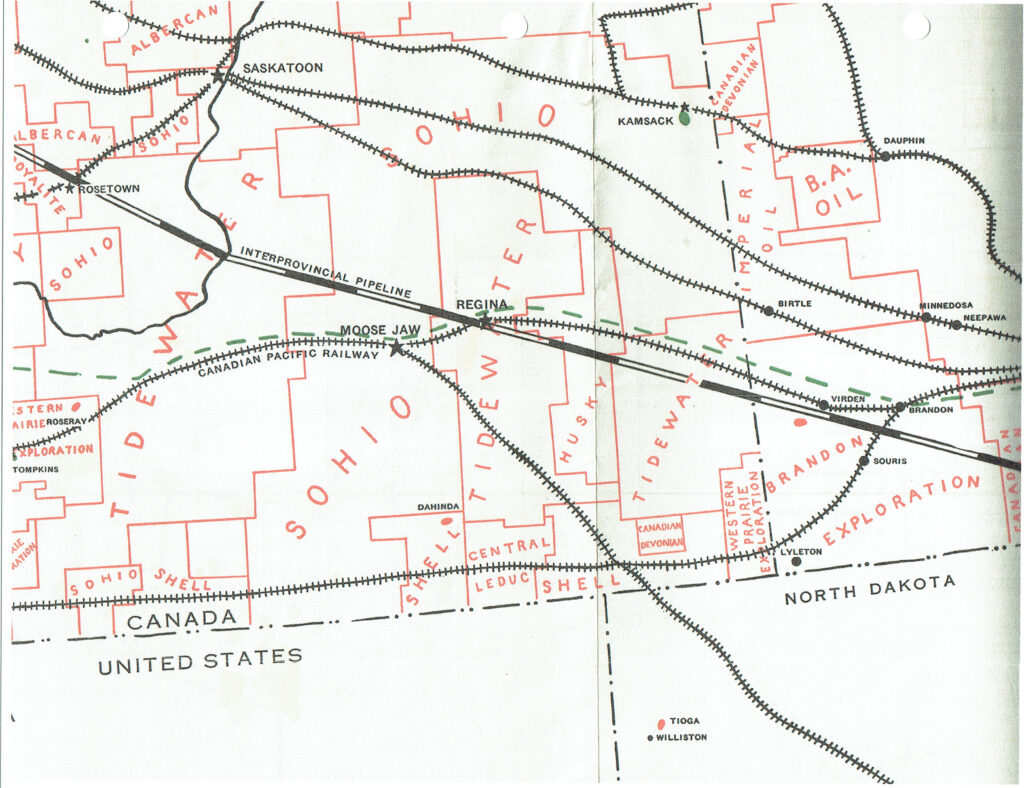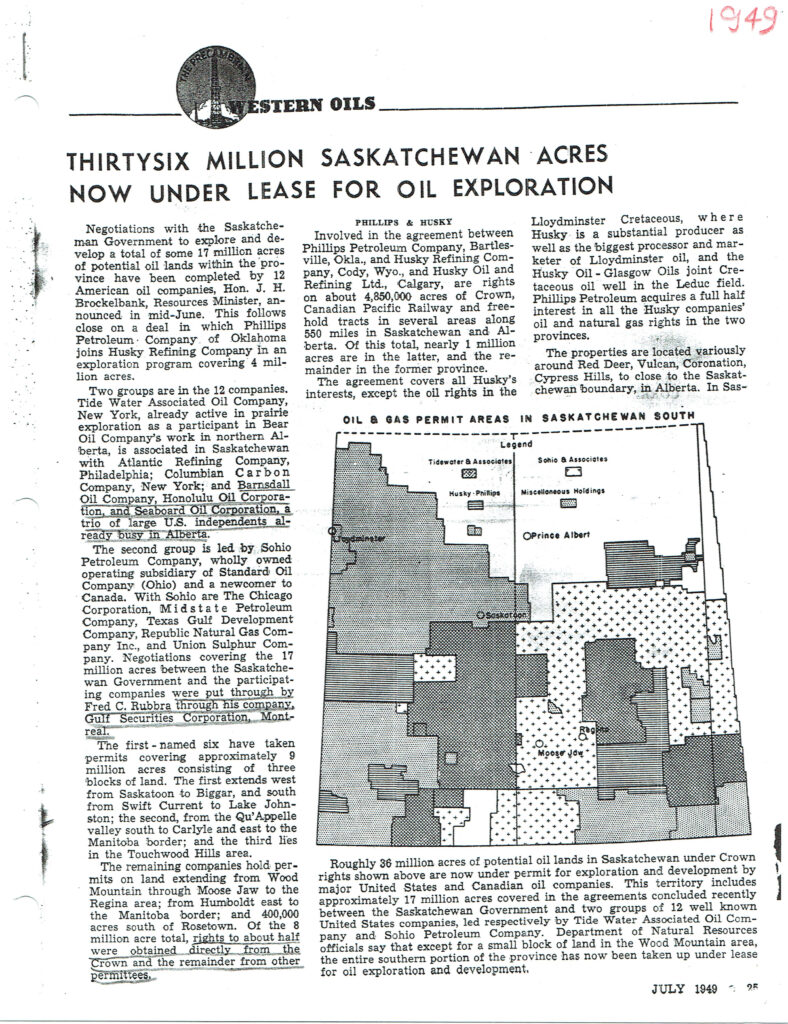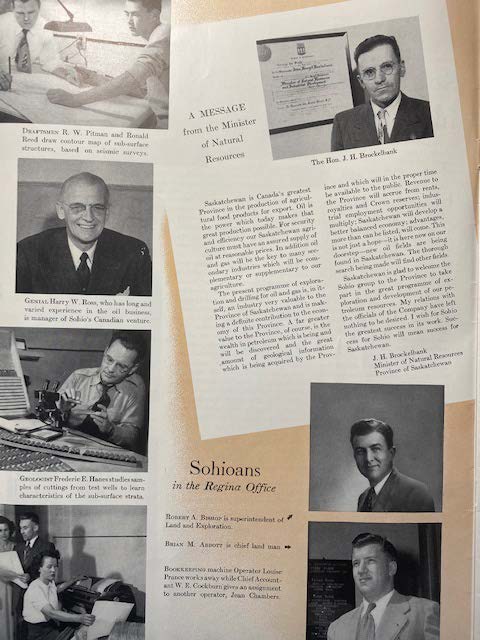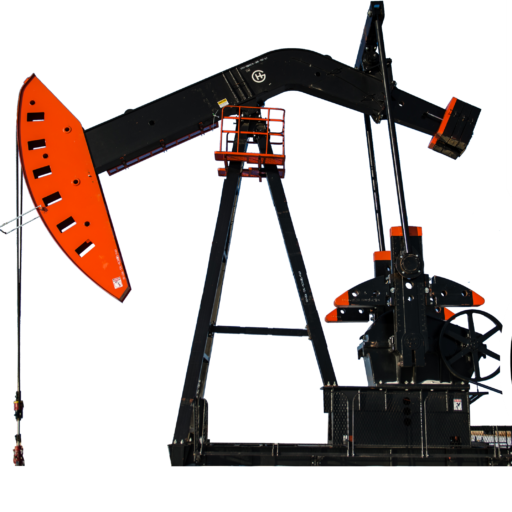From the Garage Files: Steve Halabura is one of Saskatchewan’s leading geologists

Permits blanketed southern Saskatchewan in 1949. Image courtesy Steve Halabura
We all heard the stories – Imperial Oil packing up its offices, its rigs, and hauling off to Alberta the day after Tommy Douglas and the CCF won the election – and Saskatchewan’s resource economy tanking forevermore.
A true, or apocryphal story? Hmmm… lets see.
I’ve always been a history buff, and I suppose that comes with being a geologist, because what else is geology other than the history of the earth, right? So, when, in 1986 and 1987, I had the opportunity to do a small oral history project looking at the origins of Saskatchewan’s oil industry, I leapt at it. You can read my summision about it here (pdf): New Oil from Old Ideas: Steve Halabura
The project involved speaking to some of the pioneers of Saskatchewan’s oilpatch. These people never came to an interview empty-handed, but brought along, no doubt from their garage files, documents and reports. After the talking came the writing of a paper entitled “New Oil from Old Ideas: An Historical Review of Wildcatting in Frontier Saskatchewan” and published in the Fifth Williston Basin Symposium volume, dated June 1987.
There was no doubt about the fact that the earliest exploration effort for oil and natural gas undertaken in Saskatchewan was by Imperial Oil. There was some drilling prior to Imperial’s work, undertaken by the Geological Survey of Canada and the Grand Trunk Railway; however, Imperial was the first to apply time, energy, and money to the hunt for oil.
Who was Imperial Oil? It was formed by a group of Ontario businessmen in 1880 to exploit the oil discovery at Petrolia, and its aim was to be the Standard Oil of Canada, in direct competition with John D. Rockefeller’s Standard Oil Trust. It lasted as an independent entity until 1897, when Standard Oil (later Standard Oil of New Jersey or Esso) purchased a controlling interest.
Imperial’s motivation was simple: As Canada’s first refiner of petroleum, it required a domestic supply of crude oil. In 1916 Imperial completed its 1,500 barrel per day refinery in Regina. Coincident with the refinery came the first wells drilled in the southwest and west-central areas of the province.
The early drilling was unsuccessful, so Imperial imported its feedstock from Wyoming. The First World War spiked petroleum demand, and in the ensuing decades long-term demand continued, as farmers replaced draft horses with tractors. Imperial looked not only in Saskatchewan, but also in neighboring Alberta, where the petroleum industry was much more developed, given the likes of Turner Valley.
- 0098 SASPO-2874_Self Serve Campaign_New Connects_Youtube_v30098 SASPO-2874_Self Serve Campaign_New Connects_Youtube_v3
- 0100 Turnbull Project Manager0100 Turnbull Project Manager
- 0099 Mryglod Steel 1080p0099 Mryglod Steel 1080p
- 0097 Eagle Sky Ventures LTD0097 Eagle Sky Ventures LTD
- 0095 Fast Trucking nearly 70 years good at it0095 Fast Trucking nearly 70 years good at it
- 0053 Kingston Midstream Westspur Alameda Click Before You Dig0053 Kingston Midstream Westspur Alameda Click Before You Dig
- 0092 Turnbull projects big and small0092 Turnbull projects big and small
- 0046 City of Estevan This is Estevan Teaser0046 City of Estevan This is Estevan Teaser
- 0087 Lori Carr Coal Expansion0087 Lori Carr Coal Expansion
- 0077 Caprice Resources Stand Up For Free Speech0077 Caprice Resources Stand Up For Free Speech
- 0076 Latus only0076 Latus only
- 0061 SIMSA 2024 For Sask Buy Sask0061 SIMSA 2024 For Sask Buy Sask
- 0055 Smart Power Be Smart with your Power office0055 Smart Power Be Smart with your Power office
- 0051 JML Hiring Pumpjack assembly0051 JML Hiring Pumpjack assembly
- 0049 Scotsburn Dental soft guitar0049 Scotsburn Dental soft guitar
- 0041 DEEP Since 2018 now we are going to build0041 DEEP Since 2018 now we are going to build
- 0032 IWS Summer hiring rock trailer music
- 0022 Grimes winter hiring
- 0021 OSY Rentals S8 Promo
- 0018 IWS Hiring Royal Summer
- 0013 Panther Drilling PO ad 03 top drive rigs
- 0006 JK Junior
- 0002 gilliss casing services0002 gilliss casing services
- 9002 Pipeline Online 30 sec EBEX9002 Pipeline Online 30 sec EBEX
- 9001
Then came the Second World War. In 1939 a subsidiary of Imperial Oil called Norcanols took massive permits stretching from the U.S. border north to the boreal forest treeline. Guided by several decades of scientific work done by Imperial, Norcanols and its parent Imperial drilled some of the first deep wells in Saskatchewan, drilling by 1946 fifteen wildcat wells.
In June 1944 Tommy Douglas led the Cooperative Commonwealth Federation to power, thus becoming North America’s first socialist government. Did Norcanols and Imperial immediately leave? The history says no, as Imperial attempted to extend its wartime permits and which the incumbent CCF was willing to do, save for “cosmetic” revisions to the permit language. I don’t know what “cosmetic” means, other than it obviously had a different definition to Imperial than it did to the CCF.
From what the old-timers told me, it was dry holes, not politics, that made Imperial pack its bags. Interesting seismic results were coming back from a stretch of central Alberta from Leduc to Redwater, and Imperial thought its odds might be better in Wildrose Country. The wartime permits expired, leaving almost all of Saskatchewan open for the taking.
February 13, 1947 – Leduc No. 1 blew in, and the Canadian oil sector changed forever. North America needed energy to power postwar growth, so news of a spectacular new find rivalling the early days of Spindletop caught the attention of every mid- to major oil company in America. The rush was on!
Unfortunately, when Big Oil got to Leduc, it found most, if not all, of the land taken. Canadian companies like Imperial, Royalite, Home Oil, and Pacific Petroleums controlled the real estate. But guess what? Just to the east, in neighboring Saskatchewan, vast tracts of recently-vacated Crown mineral rights were sitting there, available for the taking.
What followed was a staking rush for oil permits that had no precedent and was not to be duplicated since. American multinationals had no hesitation to meet Mr. Douglas and strike a deal for locking up tens of millions of acres. Sohio (Standard Oil of Ohio), Socony Vacuum (Standard Oil of New York), the Getty interests led by Tidewater, and California Standard all took the train to Regina and got their ground.

The permit block sizes in Saskathcewan were tremendous in 1949. Image courtesy Steve Halabura
- 0098 SASPO-2874_Self Serve Campaign_New Connects_Youtube_v30098 SASPO-2874_Self Serve Campaign_New Connects_Youtube_v3
- 0100 Turnbull Project Manager0100 Turnbull Project Manager
- 0099 Mryglod Steel 1080p0099 Mryglod Steel 1080p
- 0097 Eagle Sky Ventures LTD0097 Eagle Sky Ventures LTD
- 0095 Fast Trucking nearly 70 years good at it0095 Fast Trucking nearly 70 years good at it
- 0053 Kingston Midstream Westspur Alameda Click Before You Dig0053 Kingston Midstream Westspur Alameda Click Before You Dig
- 0092 Turnbull projects big and small0092 Turnbull projects big and small
- 0046 City of Estevan This is Estevan Teaser0046 City of Estevan This is Estevan Teaser
- 0087 Lori Carr Coal Expansion0087 Lori Carr Coal Expansion
- 0077 Caprice Resources Stand Up For Free Speech0077 Caprice Resources Stand Up For Free Speech
- 0076 Latus only0076 Latus only
- 0061 SIMSA 2024 For Sask Buy Sask0061 SIMSA 2024 For Sask Buy Sask
- 0055 Smart Power Be Smart with your Power office0055 Smart Power Be Smart with your Power office
- 0051 JML Hiring Pumpjack assembly0051 JML Hiring Pumpjack assembly
- 0049 Scotsburn Dental soft guitar0049 Scotsburn Dental soft guitar
- 0041 DEEP Since 2018 now we are going to build0041 DEEP Since 2018 now we are going to build
- 0032 IWS Summer hiring rock trailer music
- 0022 Grimes winter hiring
- 0021 OSY Rentals S8 Promo
- 0018 IWS Hiring Royal Summer
- 0013 Panther Drilling PO ad 03 top drive rigs
- 0006 JK Junior
- 0002 gilliss casing services0002 gilliss casing services
- 9002 Pipeline Online 30 sec EBEX9002 Pipeline Online 30 sec EBEX
- 9001
The Douglas government clearly welcomed the onslaught of petroleum investment. In the October 1950 edition of the “Sohioan”, Sohio’s internal corporate magazine, the Honorable J. H. Brockelbank, Minister of Natural Resources, delivered a personal message, welcoming the company and its investment in the province. “My relations with the officials of the Company have left nothing to be desired … Success for Sohio will mean success for Saskatchewan.” Hardly the words of a rabid socialist frothing to bring down the evil capitalist!

Sohioans in the Regina Office. American interest in Saskatchewan oil was pronounced, back in the 1940s. Image courtesy Steve Halabura
I think this is how the story most likely went: Fifteen dry holes is a tough nut to swallow (and that was just in Saskatchewan!), so when it came down to brass tacks, Imperial decided to cut its losses and go where it felt the odds were best in its favor. Sure enough, its hunch paid off with the Leduc discovery. A fresh bunch, following closely behind, took a hard look at the predecessor’s data and said, “Hey, I think we can do something here!” The land was divvied up by the government, and soon the discoveries began to roll in – Virden in January 1951, Coleville in August 1951, Fosterton in January 1952, Wapella in October 1952, and Midale in 1953.
To answer my opening question, “How did we get our oilpatch?”, the answer is simple: Thank you, America! American markets, American demand, and American capital led to most of the major discoveries that define our oilpatch. Picture this: Big Oil executives shaking hands with a self-declared socialist government, each wanting to make “The Big Score.”
But there is another key point to make: most of the resource plays we are familiar with today originated during that time – from potash to the Bakken, salt collapse to helium, the deep Red River to shallow bitumen – the first inklings of each of these can be found in those old wells, if you take the time to look. What other secrets do they hide?
Steve Halabura is a professional geologist whose work over the years includes potash, oil, natural gas and helium. He can be found on LinkedIn at https://www.linkedin.com/in/steve-halabura-a715461b/
- 0098 SASPO-2874_Self Serve Campaign_New Connects_Youtube_v30098 SASPO-2874_Self Serve Campaign_New Connects_Youtube_v3
- 0100 Turnbull Project Manager0100 Turnbull Project Manager
- 0099 Mryglod Steel 1080p0099 Mryglod Steel 1080p
- 0097 Eagle Sky Ventures LTD0097 Eagle Sky Ventures LTD
- 0095 Fast Trucking nearly 70 years good at it0095 Fast Trucking nearly 70 years good at it
- 0053 Kingston Midstream Westspur Alameda Click Before You Dig0053 Kingston Midstream Westspur Alameda Click Before You Dig
- 0092 Turnbull projects big and small0092 Turnbull projects big and small
- 0046 City of Estevan This is Estevan Teaser0046 City of Estevan This is Estevan Teaser
- 0087 Lori Carr Coal Expansion0087 Lori Carr Coal Expansion
- 0077 Caprice Resources Stand Up For Free Speech0077 Caprice Resources Stand Up For Free Speech
- 0076 Latus only0076 Latus only
- 0061 SIMSA 2024 For Sask Buy Sask0061 SIMSA 2024 For Sask Buy Sask
- 0055 Smart Power Be Smart with your Power office0055 Smart Power Be Smart with your Power office
- 0051 JML Hiring Pumpjack assembly0051 JML Hiring Pumpjack assembly
- 0049 Scotsburn Dental soft guitar0049 Scotsburn Dental soft guitar
- 0041 DEEP Since 2018 now we are going to build0041 DEEP Since 2018 now we are going to build
- 0032 IWS Summer hiring rock trailer music
- 0022 Grimes winter hiring
- 0021 OSY Rentals S8 Promo
- 0018 IWS Hiring Royal Summer
- 0013 Panther Drilling PO ad 03 top drive rigs
- 0006 JK Junior
- 0002 gilliss casing services0002 gilliss casing services
- 9002 Pipeline Online 30 sec EBEX9002 Pipeline Online 30 sec EBEX
- 9001
